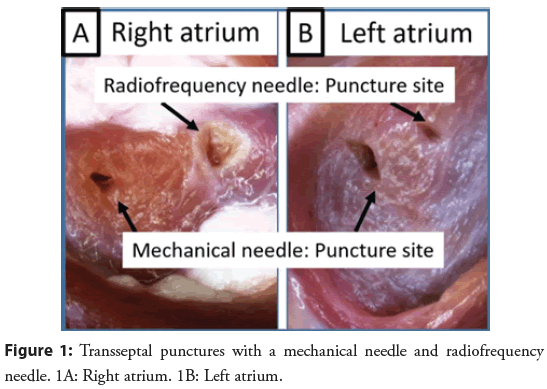Commentary - Interventional Cardiology (2021)
Tissue characteristics of transseptal punctures with mechanical and radiofrequency needles
- Corresponding Author:
- Yusuke Kondo
Department of Cardiovascular Medicine,
Chiba University Graduate School of Medicine,
Chuo-ku,
Chiba,
Japan,
E-mail: yuusukondou-circ@umin.ac.jp
Received date: August 09, 2021 Accepted date: August 23, 2021 Published date: August 30, 2021
Abstract
Description
Pulmonary Vein Isolation (PVI) has become one of the established first-line therapies for treating Atrial Fibrillation (AF). During the PVI, access to the left atrium is required via a transseptal puncture to perform cardiac ablation. Conventionally, mechanical needles have been widely used for transseptal punctures; however, the safety risk of cardiac tamponade and transseptal puncture failures are a concern. Recently, an Radio Frequency (RF) based needle with a blunt tip was introduced that delivers RF energy during the transseptal puncture, which requires less force than the mechanical needle to cross the atrial septum. In this report, both types of needles were used in a swine model to evaluate the mechanical effects on the cardiac tissue.
A 55 Kg piglet underwent transseptal puncture using both a Mechanical Needle (MN) (BRK-1TM, Abbott, MN, US) and radiofrequency needle (RFN) (NRGTM Transseptal needle, Baylis Medical, ON, Canada) via a long sheath (SwartzTM SL1TM, Abbott, MN, US). Figures A and B represent the puncture sites viewed from the right and left atria, respectively. An examination of the transseptal puncture site created by the RFN revealed a thermal lesion due to the energy delivery; however, it was not transmural. The crevices observed in the left atrium exhibited tearing and stretching caused by the MN whereas the RFN had a rounded shape as a result of the sheath crossing the atrial septum. The size of the crevice made by the MN was larger than that of the RFN even though the same long sheath was used. Transseptal puncture is an essential aspect for therapies, such as transcatheter mitral valve repair and pulmonary vein isolation, which all require access to the left atrium. The aforementioned procedures are adopted worldwide with increasing number of cases annually. Previous publications have reported iatrogenic atrial septal defect after these procedures using MN [1]. This experiment may be the first to report the effectiveness of transseptal puncture using RFN. Minimizing the tearing and stretching during the transseptal puncture may reduce long-term iatrogenic atrial septal defect.
Winkle, et al. reported a more improved transseptal puncture success rate and safety using the RFN than MN [2]. In this series, they found no cardiac perforations due to the transseptal puncture in 545 patients that underwent AF ablation. In contrast, the MN group had 9 incidences of pericardial tamponade out of 975 patients (0.92%). In addition, an greater improvement in the transseptal puncture efficacy was demonstrated in the RFN group as compared to the MN group with failure rates of 0.17% and 1.23%, respectively (P=0.039). The efficacy with respect to the time from the injection of the local anesthetic to the completion of transseptal puncture was also shorter in the RFN group than MN group (27.1 ± 10.9 minutes vs. 36.4 ± 17.7 minutes, P<0.0001). Not only is the improved efficacy clinically beneficial, but it also has a positive economic impact. Sanchez, et al. reported the findings from their economic analysis comparing the usage of the RFN versus the MN and found that the total procedural cost including transseptal-related complications for a single transseptal puncture was $41 less with the RFN ($21,096) than the MN ($21,137) [3]. This cost further improved for a double transseptal puncture resulting in a savings of $338 when the RFN was used. The efficacy and reduction in the complications were the main contributing factors to the cost savings and may benefit hospitals performing AF ablation.
Conclusion
In conclusion, our swine study revealed that the transseptal puncture by the RFN causes less trauma to the cardiac tissue in comparison to the MN. Our visual findings of the effect on the cardiac tissue lend support to the previous reports on the effectiveness and safety of the RFN over the MN for transseptal punctures. Furthermore, the RFN could potentially minimize the risk of iatrogenic atrial septal defects caused by the transseptal puncture.
Disclosures
The authors have no competing interests, funding or financial relationships to disclose.
References
- Alkhouli M, Sarraf M, Zack CJ, et al. Iatrogenic atrial septal defect following transseptal cardiac interventions. Int J Cardiol. 209: 142-8 (2016).
- Winkle RA, Mead RH, Engel G, et al. The use of a radiofrequency needle improves the safety and efficacy of transseptal puncture for atrial fibrillation ablation. Heart Rhythm. 8(9): 1411-5 (2011).
- Sanchez JM, Shah R, Kouassi Y, et al. A cost-effectiveness analysis comparing a conventional mechanical needle to a radiofrequency device for transseptal punctures. J Cardiovasc Electrophysiol. 31(7):1672-7 (2020).


